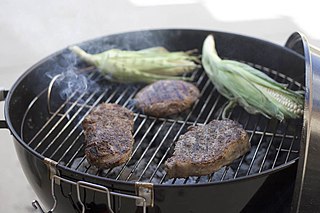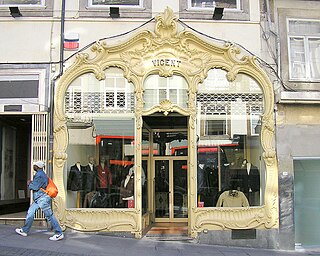
Grilling is a form of cooking that involves heat applied to the surface of food, commonly from above, below or from the side. Grilling usually involves a significant amount of direct, radiant heat, and tends to be used for cooking meat and vegetables quickly. Food to be grilled is cooked on a grill, using a cast iron/frying pan, or a grill pan.

Heating, ventilation, and air conditioning (HVAC) is the use of various technologies to control the temperature, humidity, and purity of the air in an enclosed space. Its goal is to provide thermal comfort and acceptable indoor air quality. HVAC system design is a subdiscipline of mechanical engineering, based on the principles of thermodynamics, fluid mechanics, and heat transfer. "Refrigeration" is sometimes added to the field's abbreviation as HVAC&R or HVACR, or "ventilation" is dropped, as in HACR.

A blacksmith is a metalsmith who creates objects primarily from wrought iron or steel, but sometimes from other metals, by forging the metal, using tools to hammer, bend, and cut. Blacksmiths produce objects such as gates, grilles, railings, light fixtures, furniture, sculpture, tools, agricultural implements, decorative and religious items, cooking utensils, and weapons. There was an historical distinction between the heavy work of the blacksmith and the more delicate operation of a whitesmith, who usually worked in gold, silver, pewter, or the finishing steps of fine steel. The place where a blacksmith works is called variously a smithy, a forge or a blacksmith's shop.

A barbecue grill or barbeque grill is a device that cooks food by applying heat from below. There are several varieties of grills, with most falling into one of three categories: gas-fueled, charcoal, or electric. There is debate over which method yields superior results.

Ironwork is any weapon, artwork, utensil, or architectural feature made of iron, especially one used for decoration. There are two main types of ironwork: wrought iron and cast iron. While the use of iron dates as far back as 4000 BC, it was the Hittites who first knew how to extract it and develop weapons. Use of iron was mainly utilitarian until the Middle Ages; it became widely used for decoration in the period between the 16th and 19th century.

An attic is a space found directly below the pitched roof of a house or other building; an attic may also be called a sky parlor or a garret. Because attics fill the space between the ceiling of the top floor of a building and the slanted roof, they are known for being awkwardly shaped spaces with difficult-to-reach corners and often exposed rafters.
Grill or grille may refer to:

Jean Tijou was a French Huguenot ironworker. He is known solely through his work in England, where he worked on several of the key English Baroque buildings. Very little is known of his biography. He arrived in England in c. 1689 and enjoyed the patronage of William III and Mary II where he was titled as England's Best Wrought-iron Designer. He was employed at St Paul's for twenty years. Not only did he work for royal destinations, but he also worked for estates and other private homes located on the countryside. He left England for the continent c. 1712. He was father-in-law to the painter of decorative schemes Louis Laguerre who married in St Martin-in-the-Fields in London. Tijou had a wife named Ann Tijou as well as a daughter. She was married in the church of St. Martin's. Both wife and daughter were buried there as well.

Ducts are conduits or passages used in heating, ventilation, and air conditioning (HVAC) to deliver and remove air. The needed airflows include, for example, supply air, return air, and exhaust air. Ducts commonly also deliver ventilation air as part of the supply air. As such, air ducts are one method of ensuring acceptable indoor air quality as well as thermal comfort.
Edgar William Brandt was a French ironworker and prolific weapons designer. In 1901 he set up a small workshop at 76 rue Michel-Ange in the 16th arrondissement in Paris, where he began designing, silversmithing, and forging small items such as jewelry, crosses, and brooches. His business began to take off with special commissions such as the door of the French Embassy in Brussels, the Escalier Mollien stairs in the Louvre, and the stair and balcony railing for the Grand Theatre Municipal de Nancy.

Metals used for architectural purposes include lead, for water pipes, roofing, and windows; tin, formed into tinplate; zinc, copper and aluminium, in a range of applications including roofing and decoration; and iron, which has structural and other uses in the form of cast iron or wrought iron, or made into steel. Metal alloys used in building include bronze ; brass ; monel metal and nickel silver, mainly consisting of nickel and copper; and stainless steel, with important components of nickel and chromium.
Perforated metal, also known as perforated sheet, perforated plate, or perforated screen, is sheet metal that has been manually or mechanically stamped or punched using CNC technology or in some cases laser cutting to create different holes sizes, shapes and patterns. Materials used to manufacture perforated metal sheets include stainless steel, cold rolled steel, galvanized steel, brass, aluminum, tinplate, copper, Monel, Inconel, titanium, plastic, and more.
John Rais is a designer, blacksmith and sculptor known for his architectural work, vessels, and furniture. Rais primarily works in steel as well as titanium, bronze, copper, stainless steel, and other materials. He is well known for his one-of-a-kind firescreens. Rais was born and raised in Burlington, Massachusetts, the youngest of seven children. Rais was introduced to blacksmithing in a sculpture class at the age of 18. He went to college at the Massachusetts College of Art, graduating in 1995, BFA Sculpture. After working at an architectural ironworks and a living history museum in Massachusetts, he decided to go to graduate school. Rais received his masters of fine arts degree from Cranbrook Academy of Art in 1998, after which he worked at Peters Valley Craft Center as a department head. Rais was a department head of blacksmithing at Peter's Valley from 1998 to 2001. He has run his own design and metalsmithing studio since 1998. He now resides in Philadelphia, PA.
HVAC is a major sub discipline of mechanical engineering. The goal of HVAC design is to balance indoor environmental comfort with other factors such as installation cost, ease of maintenance, and energy efficiency. The discipline of HVAC includes a large number of specialized terms and acronyms, many of which are summarized in this glossary.

Casa Vicent is a historic building in the civil parish of Santo Ildefonso, in the Portuguese city of Porto. Located in the historic lower town, the shop is notable for the Art Nouveau and Rococo elements and undulating forms of its iron facade; it is similar to the facades of the Ourivesaria Cunha and Ourivesaria Reis along the same road, all constructed by the Companhia Aliança.

Openwork or open-work is a term in art history, architecture and related fields for any technique that produces decoration by creating holes, piercings, or gaps that go right through a solid material such as metal, wood, stone, pottery, cloth, leather, or ivory. Such techniques have been very widely used in a great number of cultures.

The U.S. Customs House,, located at Calle Union, Fajardo, Puerto Rico, was constructed in 1930. The poured-concrete building is significant architecturally and historically for the role it played in the first, transitional phase of the American customs service in Puerto Rico, from 1898 through 1931. This period is bracketed on one end by the cession, on December 10, 1898, of the island of Puerto Rico to the United States by Spain as a condition of the Treaty of Paris ending the Spanish–American War, and on the other by the completion in 1931 of the major building and rehabilitation program undertaken by the U.S. Customs Service following World War I.

A register is a grille with moving parts, capable of being opened and closed and the air flow directed, which is part of a building's heating, ventilation, and air conditioning (HVAC) system. The placement and size of registers is critical to HVAC efficiency. Register dampers are also important, and can serve a safety function.

Cyril Colnik was a metalsmith originally from Austria sometimes called "The Tiffany of wrought iron".. He emigrated to the United States to attend the 1893 World's Columbian Exposition in Chicago, where he won a gold medal for his entry to the exposition.





















